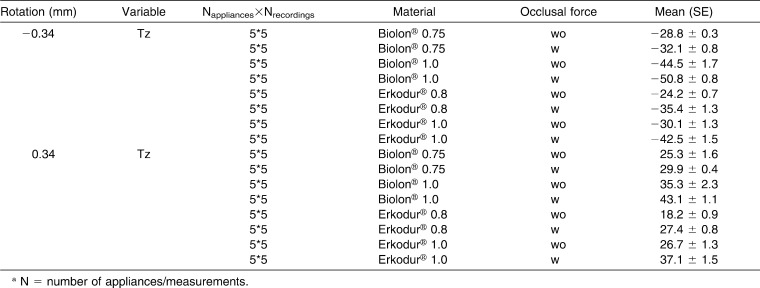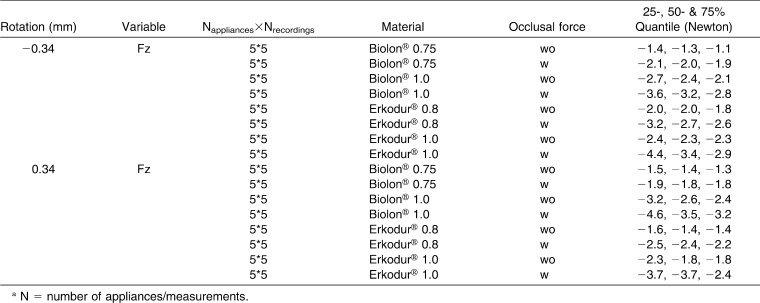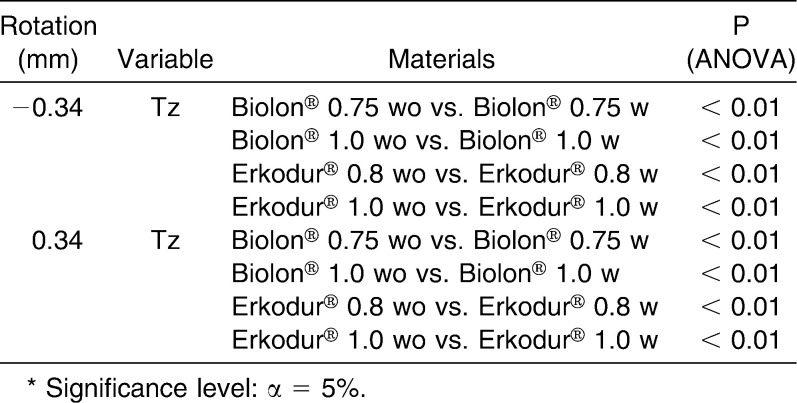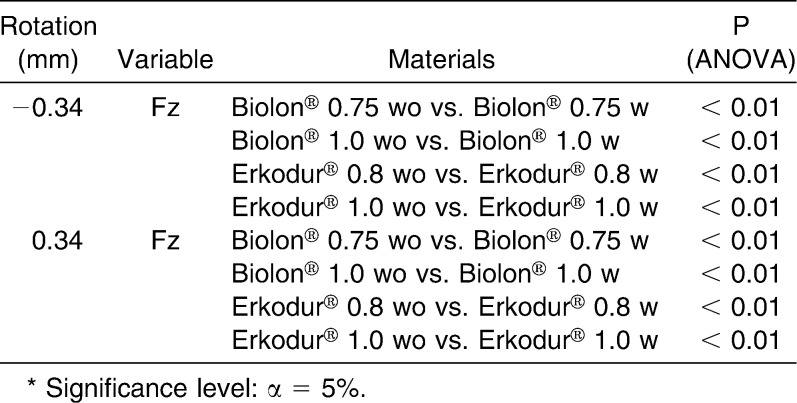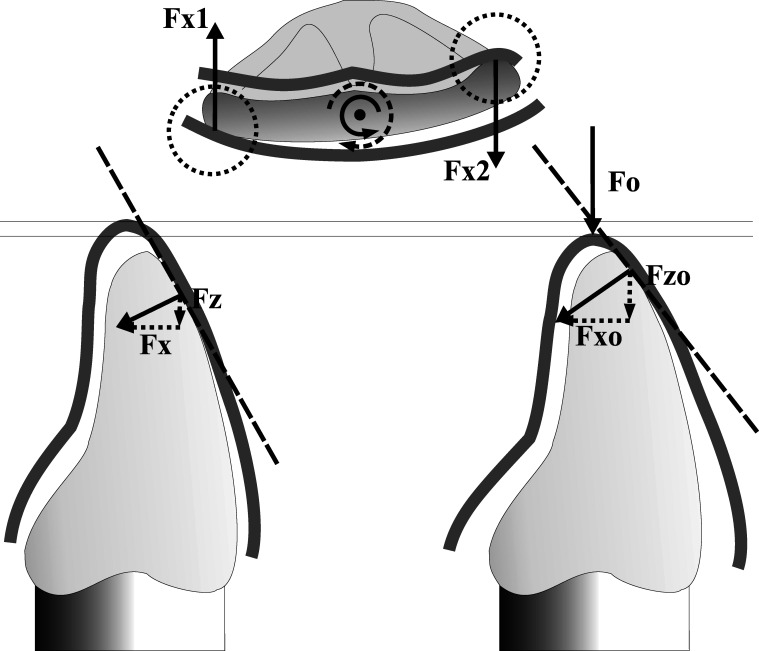Abstract
Objective:
To determine the forces and moments delivered to a maxillary central incisor during rotation with aligners when a simulated occlusal force generated during swallowing acts on the appliance.
Materials and Methods:
Five identical appliances were manufactured from four different starting materials (Erkodur 0.8 mm and 1.0 mm; Biolon 0.75 mm and 1.0 mm). An upper central incisor fixed in a measuring device was rotated around its central axis in 0.5-degree steps up to ±10 degrees with the appliance fixed in place. An occlusal force of 30 N generated during swallowing was simulated with a weight positioned on the appliance. For statistical analysis, the moments Tz (rotation) and forces Fz (intrusion) at a deflection of ±0.34 mm to the incisor edge (±5 degrees rotation) were tested. Means and standard deviations for Tz and median and 25% and 75% quartiles for Fz were calculated. An analysis of variance was performed.
Results:
The simulated occlusal force increased the measured intrusive force Fz (maximum with a weight, −3.7 N [−3.7, −2.4]; minimum without a weight, −1.3 N [−1.4, −1.1]) and the rotary moment Tz (maximum with a weight, −50.8 Nmm [±0.8]; minimum without a weight, 18.2 Nmm [±0.9]) significantly in all cases (P < .01). This was found for all materials measured and for both directions of rotation.
Conclusion:
During rotation with aligners, a simulated occlusal force increases the intrusive force and the rotary moment. The biological adverse side effects of these phenomena remain unclear, especially in patients with periods of bruxism.
Keywords: Occlusal forces, Aligner
INTRODUCTION
When a tooth is moved by aligners, the forces acting on it are evoked by reversible deformation of the aligner in various ways.1–3 As has been shown before, during this deformation the aligner tends to lift up from the teeth, especially near the misaligned tooth, and therefore becomes deformed in the shape of a bow.4 This mechanism is one among others evoking the forces acting on the tooth to be moved.
During swallowing, an occlusal contact between the upper and lower row of teeth results in a vertically acting force, on average about 30 N.5 When an aligner is used to induce tooth movement, the resultant force system may be modified by the occlusal forces acting during swallowing by pressing the lifted aligner back on teeth.
The aim of the present study was to evaluate whether and how this vertically acting force during swallowing affects the initial forces and moments delivered by removable thermoplastic appliances during rotation of an upper central incisor.
MATERIALS AND METHODS
Measurements were carried out with a modular measuring device consisting of an axially rotatable, maxillary central incisor (measuring tooth) as part of a standardized resin model (Frasaco GmbH, Tettnang, Germany). The measuring tooth was fixed on a sensor (Nano 17 sensor, ATI Industrial Automation, Apex, NC), which was positioned on a rotary stage (DT 130, OWIS GmbH, Staufen, Germany) for rotating the measuring tooth axially. The measuring device was then connected to a climate chamber to simulate oral moisture and temperature conditions. The modular measuring device has been described in detail before.1–4
After rigging the measuring device, an impression (Tetrachrom, Kanidenta, Herford, Germany) with the measuring tooth in the zero position was taken and then a plaster model (GC Fujirock EP, GC Germany GmbH, Munich, Germany) was produced with a height of 20 mm parallel to the occlusal plane. Subsequently, 20 identical plaster copies (GC Fujirock EP, GC Germany GmbH, Munich, Germany) of the model were made using Adisil blue 9∶1 (SILADENT Dr. Böhme & Schöps GmbH, Goslar, Germany). From each material evaluated, five similarly designed appliances were manufactured based on these models.
For the present study, the following materials and their corresponding forming machines were used: Biolon 0.75 mm and 1.0 mm (Dreve Dentamid GmbH, Unna, Germany) with Drufomat-TE (Dreve Dentamid GmbH), Erkodur 0.8 mm and 1.0 mm (Erkodent Erich Kopp GmbH, Pfalzgrafenweiler, Germany) with Erkoform RVE (Erkodent Erich Kopp GmbH).
For measuring the forces and moments delivered during rotation, two measuring cycles were completed with each appliance—one without and one with a simulated vertically acting force generated by swallowing. For simulating the average occlusal force of approximately 30 N acting during swallowing, two weights (each 1.5 kg) were reproducibly positioned on the center of the aligner using a silicon positioning key (Picodent twinduo, Picodent Dental-Produktions- und Vertriebs- GmbH, Wipperfürth, Germany).5 The anterior parts of the aligner near the measuring tooth did not come into contact with the weights and the silicon key to avoid a direct influence of the weights on the deformation of the aligner during rotation.
During each measuring cycle, the tooth was rotated along its central axis in 0.5-degree steps from 0 degrees to 10 degrees, then back to 0 degrees, and from 0 degrees to −10 degrees, then back to 0 degrees. After moistening the inner surfaces of the appliances with artificial saliva (University Pharmacy, Goettingen, Germany), measurements were carried out at 37°C in the drying chamber. Forces and moments measured by the sensor were set to zero before starting the measuring cycle. After each step in rotation, five recordings of the measurements were made.
For comparison of the two materials from the measured forces (Fx, Fy, and Fz) and moments (Tx, Ty, and Tz), the values for the intrusive force Fz and the rotational moment Tz at angles of ±5 degree were used (equivalent to ±0.34 mm distance moved in millimeters from the mesial and distal end point of the incisor edge, respectively).
The value of ±0.34 mm was chosen because it is approximately an average value of common activation ranges used in aligner therapy (Invisalign appliance, Align Technology, Santa Clara, CA, between 0.15 mm and 0.33 mm6,7 and Clear Smile appliance, Woollongong, Australia, 0.5 mm).8
Statistical Analysis
Because of the observed hysteresis, only the Fz and Tz values measured during increasing rotation in a particular direction were taken for further analysis.
The forces (Fz) and moments (Tz) measured for the four materials at an activation range of ±0.34 mm with and without a simulated swallowing force were compared by analysis of variance (ANOVA) for repeated measurements. For the analysis of the Fz values, a nonparametric version of ANOVA was used, because the distribution was skewed. The Tz values were analyzed with a parametric ANOVA. Hence, Tz values are represented by means (± SE) and Fz values by medians (25% quantiles and 75% quantiles). The analyses were performed with SAS (version 9.1, SAS Institute, Cary, NC). The significance level was set to α = 5%.
RESULTS
The simulated occlusal force significantly increased the measured intrusive force and the rotary moment Tz in all cases (P < .01). This was the case for all materials measured (Tables 1 and 2; Figures 1 and 2).
Table 1.
Means and Standard errors (SEs) for the Moment Tz for the Materials Evaluated (Biolon 0.75 and 1.0 mm, Erkodur 0.8 and 1.0 mm) for the Particular Activation Ranges (±0.34 mm) Without and With a Simulated Occlusal Force During Swallowinga
Table 2.
Median (50% Quantile) and 25% and 75% Quantiles for the Force Fz for the Materials Evaluated (Biolon 0.75 and 1.0 mm, Erkodur 0.8 and 1.0 mm) for the Particular Activation Ranges (±0.34 mm) Without and With a Simulated Occlusal Force During Swallowinga
Figure 1.
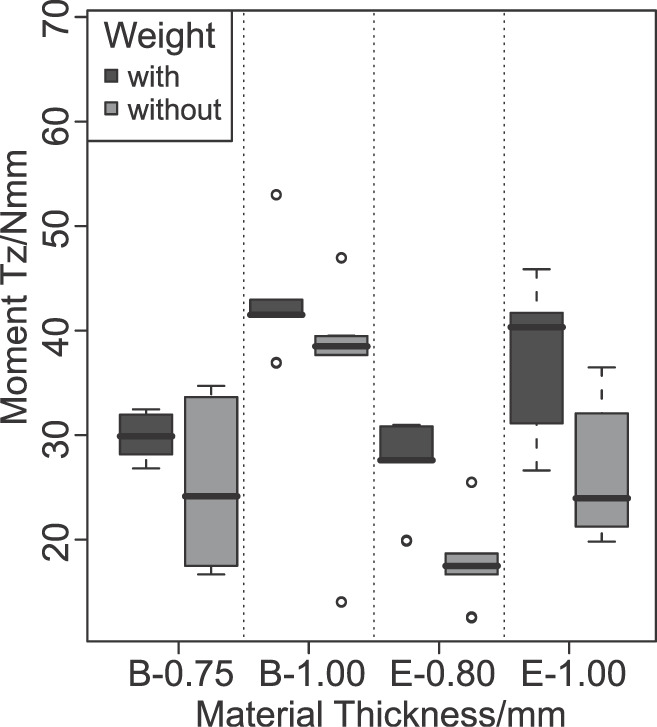
Box plots illustrating the measured moments Tz/Nmm for each material evaluated (B = Biolon, E = Erkodur) at an activation range of +0.34 mm with and without a simulated occlusal force acting on the aligner during swallowing.
Figure 2.
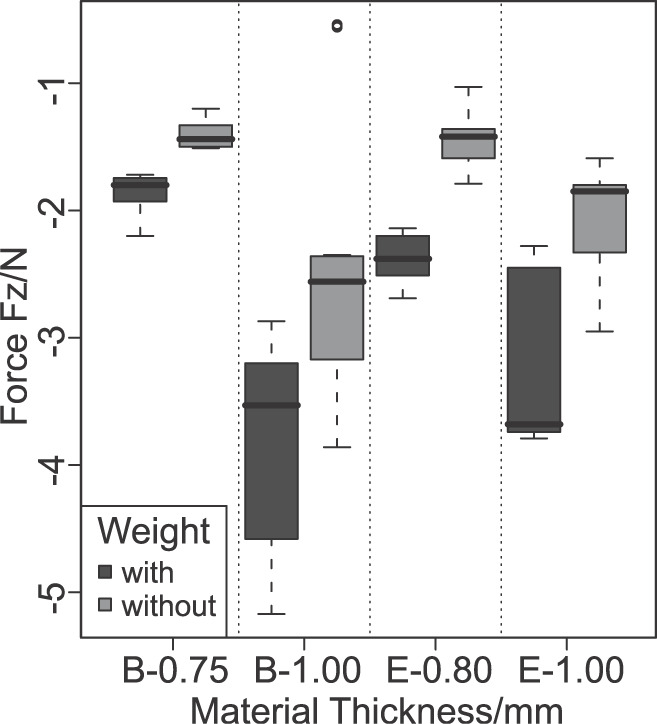
Box plots illustrating the measured forces Fz/N for each material evaluated (B = Biolon, E = Erkodur) at an activation range of +0.34 mm with and without a simulated occlusal force acting on the aligner during swallowing.
Means and standard deviations for the moment Tz at the distances of ±0.34 mm moved are given for each material in Table 3 and Figure 1. The corresponding results for Fz are shown in Table 4 and Figure 2 in terms of the median (50% quantile) and the 25% and 75% quantiles.
Table 3.
Results of Pairwise Analyses of Variance (ANOVA) for the Force Tz for the Materials Evaluated (Biolon 0.75 and 1.0 mm, Erkodur 0.8 and 1.0 mm) for the Particular Activation Ranges (±0.34 mm) Without and With a Simulated Occlusal Force During Swallowing
Table 4.
Results of Pairwise Analyses of Variance (ANOVA) for the Force Fz for the Materials Evaluated (Biolon 0.75 and 1.0 mm, Erkodur 0.8 and 1.0 mm) for Specific Activation Ranges (±0.34 mm) Without and With a Simulated Occlusal Force During Swallowing
The Biolon 1.0 mm aligners always showed the highest measured values for Tz irrespective of the simulated occlusal force (Tz at a rotation of −3.4 mm without simulated occlusal force, −44.5 Nmm [±1.7] and with simulated occlusal force −50.8 Nmm [±0.8]).
The lowest moments measured were delivered by the Erkodur 0.8 mm appliances (Tz at a rotation of 3.4 mm without simulated occlusal force, 18.2 Nmm [± 0.9], and with simulated occlusal force, 27.4 Nmm [± 0.8]).
In general, the Tz values measured for the negative rotation direction (−3.4 mm) were always lower than those for the positive rotation (+3.4 mm).
In contrast, the trend for the Fz values as a function of the material evaluated was not as clear as for the Tz values. The highest mean intrusive force Fz was delivered by the Ekodur 1.0 mm appliances at a rotation of 3.4 mm with a simulated occlusal force (Fz: −3.7 N [−3.7, −2.4]). But, the Biolon 1.0 mm aligner delivered the highest mean value for the intrusive force at an activation range of 0.34 mm if no occlusal force was simulated (Fz: −2.6 N [−3.2, −2.4]).
The lowest mean intrusive force Fz was delivered by the Biolon 0.75 mm appliances at a rotation of −3.4 mm without a simulated occlusal force (Fz: −1.3 [−1.4, −1.1]). When an occlusal force was simulated, the lowest mean intrusive force Fz was also delivered by the Biolon 0.75 mm appliances at an activation range of 3.4 mm (Fz: −1.8 N [−1.9, −1.8]).
DISCUSSION
The forces of dental occlusion during swallowing are described in the literature as being heterogeneous. Proffit et al.5 quoted values from 29 to 48 N when comparing normal with long-faced adults. For adults with 2.5 mm jaw separation, which is approximately the case when an aligner is applied, the authors reported a mean value of 29 N. Dos Santos and de Rijk9 described values between 5 and 15 N. For the present study, a weight of 3 kg (30 N) was used, which represents an average value obtained from the literature and accounts for the jaw separation associated with aligners.
In contrast to the clinical situation, in our setup the occlusal force acts continuously, whereas in a patient the swallowing cycle just takes a few seconds.5 During this cycle, the force increases and decreases and does not constantly remain at the same level. As a consequence, the amount of forces acting on the aligner over the whole day in a clinical situation is probably smaller unless there is grinding or clenching.
Regardless of the activation direction, the material used, and whether an appliance with a spacer foil (Erkodur) or one without (Biolon) was used, the simulated occlusal force acting on the aligner during swallowing increased the delivered force and moments significantly. Hence, a biomechanical principle can be postulated as being responsible for the observations.
As described in a former study,4 the forces and moments that are required for axial rotation of an upper central incisor are typically generated in two ways. First, the fitting discrepancy between aligner and the tooth to be moved produces a local deformation in the inner surfaces of the aligner inclined in the vestibular and palatal directions. As a consequence, an axial rotary moment Tz is produced by two horizontal forces acting in opposite directions. Because these forces are generated by deformation of convergent inclined surfaces, an intrusive force, Fz, results. Second, the appliance rises up in the anterior region as a result of the incongruity between the tooth and the aligner, and it remains on the posterior teeth because of friction. Consequently, this tends to deform the appliance like a bow, so a reactive force is generated that acts intrusively on the tooth to be moved. Via the inclined inner surfaces at the contact area between the misaligned tooth and the aligner, this intrusively acting force aggravates the rotary moment Tz, as well as the intrusive force Fz (Figure 3).4
Figure 3.
When the tooth is rotated before therapy around its central axis (circuit arrow with continuous line), two major contact areas in the vestibular and palatal directions between the crown and the inner surfaces of the appliance result (dotted circles).4 At these contact areas, two oppositely acting horizontal forces (Fx1/Fx2) result, which produce the moment Tz (circuit arrow with dotted line). The influence of the occlusal force on the force system delivered on the tooth by the aligner is shown for the vestibular contact area. At the inclined contact area between appliance and tooth (dotted tangent lines), vertical (Fz) and horizontal (Fx) force components are produced. An occlusal force (Fo) counteracts the lifting up of the appliance and so the aligner cannot avoid the misaligned tooth by lifting. Consequently, the local deformation of the inclined inner surface of the aligner increases. This aggravates the resulting forces (Fxo, Fzo). In addition, by pressing the aligner on the tooth, the contact area between aligner and tooth tends to move nearer to the incisor edge where the aligners' rigidity is reinforced compared with areas closer to the gingival margin.3 This again increases the forces delivered on the tooth by the aligner.
As shown by the present study, the forces and moments measured increase significantly during rotation with a simulated occlusal force, which mainly acts in the posterior region of the appliance. This result supports the observation that the forces applied for tooth movement with aligners are not just generated via local deformation, but also as a result of deformation in the shape of a bow of the whole aligner, as described before.4 If only the local deformation of the aligner at the contact point between aligner and tooth to be moved were to be responsible for force delivered by the aligner, an occlusal force acting on the aligner would have no influence at all on the forces delivered. The simulated occlusal force antagonizes the lifting up of the appliance and thereby aggravates the intrusively acting force caused by whole-body deformation of the aligner. Moreover, because the aligner cannot evade the misaligned tooth by lifting up, because of the occlusal force, the local deformation at the contact point between aligner and tooth must be more pronounced. This again aggravates the forces delivered by the aligner (Figure 3). Finally, because the aligner is pressed back on the tooth, the contact area between the aligner and the tooth tends to move nearer to the incisor edge where the aligners' rigidity is reinforced compared with areas nearer to the gingival margin.3 This again increases the forces delivered to the tooth by the aligner.
In our study, the tooth is progressively rotated, which leads to an increasing lifting up of the aligner, whereas in the patient the aligner would be initially incompletely seated on the rotated tooth, and after tooth movement, the seating of the aligner would be progressively better. In our view, this has no general influence on the biomechanical principles observed in the study. Nevertheless, the magnitude of the measured values could be slightly different because of different friction modalities between the tooth and the aligner under the two different conditions.
As has already been reported,4 even during a rotation of an upper central incisor with aligners (deflection of ±0.34 mm), without occlusal forces the limits given in the literature10,11 for ideal moments are exceeded by up to three times. The limits for the intrusive forces12 are mostly exceeded by up to 13 times when no weight is applied, but when an occlusal force was simulated, as is the case during swallowing, the reference values were exceeded by a factor of up to 3 and a half times for Tz and up to 18 times for Fz, respectively.
Because low forces are desired,12 especially for intrusion, it is reasonable to ask whether the increasing force during swallowing may override the problem of root resorption.13–15
As has been discussed before,1,2 the lifting up of the aligner, which leads to lower local deformation, acts as a self-protecting mechanism, which may be responsible for the low rate of root resorption seen with aligners.13–15
In this context, the occlusal force caused by swallowing can act as a readjustment of the appliance after the tooth has moved a little. Because an average person swallows between 590 and 2400 times over a period of 24 hours,16–18 the aligner frequently becomes reactivated by being pressed back on the teeth.
Although the forces and moments delivered by the aligner during swallowing are much greater than those quoted as ideal values in the literature,12 these force peaks caused by swallowing are acting as pulses for approximately 1.5 seconds per swallowing cycle.18,19 These short pulsed periods of pressure, which increase in the periodontal gap, are probably compensated by the visco-elastic properties of the periodontal ligament and therefore no increased root resorption and no influence on tooth movement velocity are to be expected.20–23
In contrast, if one suffers from bruxism, much longer-acting and greater occlusal forces pressing on the aligner are to be expected.24 The question of whether this has a negative impact on the rate of root resorption or not remains unanswered.
CONCLUSIONS
An occlusal force such as that generated during swallowing, when acting on an aligner, increases the measurable intrusive forces and rotary moments present during the rotation of a maxillary central incisor.
Because these observations were independent of the material used and the direction of activation, biomechanical principles associated with this force increase can be identified.
Although as a result of the swallowing force the forces and moments delivered by the aligner were increased by a far greater magnitude than the ideal values to be read in the literature, a negative impact on the rate of root resorption appears unlikely because of the pulse character of the force peaks.
REFERENCES
- 1.Hahn W, Dathe H, Fialka-Fricke J, Fricke-Zech S, Zapf A, Kubein-Meesenburg D, Sadat-Khonsari R. Influence of thermoplastic appliances' thickness on the magnitude of force delivered to an upper central incisor during tipping. Am J Orthod Dentofac Orthop. 2009;136(1):12.e1–e7. doi: 10.1016/j.ajodo.2008.12.015. [DOI] [PubMed] [Google Scholar]
- 2.Hahn W, Fialka-Fricke J, Dathe H, Fricke-Zech S, Zapf A, Gruber R, Kubein-Meesenburg D, Sadat-Khonsari R. Initial forces generated by three types of thermoplastic appliances on an upper central incisor during tipping. Eur J Orthod. 2009;31:625–631. doi: 10.1093/ejo/cjp047. [DOI] [PubMed] [Google Scholar]
- 3.Hahn W, Zapf A, Dathe H, Fialka-Fricke J, Fricke-Zech S, Gruber R, Kubein-Meesenburg D, Sadat-Khonsari R. Torquing an upper central incisor with aligners—acting forces and biomechanical principles. Eur J Orthod. doi: 10.1093/ejo/cjq007. 2010 May 12. [Epub ahead of print.] [DOI] [PubMed] [Google Scholar]
- 4.Hahn W, Engelke B, Jung K, Dathe H, Fialka-Fricke J, Kubein-Meesenburg D, Sadat-Khonsari R. Initial forces and moments delivered by removable thermoplastic appliances during rotation of an upper central incisor. Angle Orthod. 2010;80:239–246. doi: 10.2319/033009-181.1. [DOI] [PMC free article] [PubMed] [Google Scholar]
- 5.Proffit W. R, Fields H. W, Nixon W. L. Occlusal forces in normal- and long-face adults. J Dent Res. 1983;62:566–570. doi: 10.1177/00220345830620051201. [DOI] [PubMed] [Google Scholar]
- 6.Kravitz N. D, Kusnoto B, BeGole E, Obrez A, Agran B. How well does Invisalign work? A prospective clinical study evaluating the efficacy of tooth movement with Invisalign. Am J Orthod Dentofac Orthop. 2009;135:27–35. doi: 10.1016/j.ajodo.2007.05.018. [DOI] [PubMed] [Google Scholar]
- 7.Boyd R. L, Vlascalic V. Three-dimensional diagnosis and orthodontic treatment of complex malocclusions with the Invisalign appliance. Semin Orthod. 2001;7:274–293. [Google Scholar]
- 8.Barbagallo L. J, Shen G, Jones A. S, Swain M. V, Petocz P, Darendeliler M. A. A novel pressure film approach for determining the force imparted by clear removable thermoplastic appliances. Ann Biomed Eng. 2008;36:335–341. doi: 10.1007/s10439-007-9424-5. [DOI] [PubMed] [Google Scholar]
- 9.Dos Santos J, Jr, de Rijk W. G. Occlusal contacts: vectorial analysis of forces transmitted to temporomandibular joint and teeth. Cranio. 1993;11(2):118–125. doi: 10.1080/08869634.1993.11677953. [DOI] [PubMed] [Google Scholar]
- 10.Lapatki B. G, Paul O. Smart brackets for 3D-force-moment measurements in orthodontic research and therapy—developmental status and prospects. J Orofac Orthop. 2007;68:377–396. doi: 10.1007/s00056-007-0728-8. [DOI] [PubMed] [Google Scholar]
- 11.Lapatki B. G, Bartholomeyczik J, Ruther P, Jonas I. E, Paul O. Smart bracket for multi-dimensional force and moment measurement. J Dent Res. 2007;86(1):73–78. doi: 10.1177/154405910708600112. [DOI] [PubMed] [Google Scholar]
- 12.Proffit W. R. Contemporary Orthodontics 3rd ed. St Louis, MO: Mosby; 2000. [Google Scholar]
- 13.Barbagallo L. J, Jones A. S, Petocz P, Darendeliler M. A. Physical properties of root cementum: Part 10. Comparison of the effects of invisible removable thermoplastic appliances with light and heavy orthodontic forces on premolar cementum. A microcomputed-tomography study. Am J Orthod Dentofac Orthop. 2008;133:218–227. doi: 10.1016/j.ajodo.2006.01.043. [DOI] [PubMed] [Google Scholar]
- 14.Boyd R. L. Esthetic orthodontic treatment using the Invisalign appliance for moderate to complex malocclusions. J Dent Educ. 2008;72:948–967. [PubMed] [Google Scholar]
- 15.Brezniak N, Wasserstein A. Root resorption following treatment with aligners. Angle Orthod. 2008;78:1119–1124. doi: 10.2319/112807-562.1. [DOI] [PubMed] [Google Scholar]
- 16.Kincaid R. M. The frequency of deglutition in man: its relationship to overbite. Angle Orthod. 1951;21(1):34–43. doi: 10.1043/0003-3219(1951)021<0034:TFODIM>2.0.CO;2. [DOI] [PubMed] [Google Scholar]
- 17.Lear C. S, Flanagan J. B, Jr, Moorrees C. F. The frequency of deglutition in man. Arch Oral Biol. 1965;10:83–100. doi: 10.1016/0003-9969(65)90060-9. [DOI] [PubMed] [Google Scholar]
- 18.Witt E. Timper E: Experimentelle Untersuchungen über Schluckdauer und Schluckhäufigkeit bei Kindern und Erwachsenen mit verschiedenen Anomalien. J Orofac Orthop. 1974;35:306–322. [Google Scholar]
- 19.Cleall J. F. Deglutition: a study of form and function. Am J Orthod. 1965;51:566–594. doi: 10.1016/0002-9416(65)90028-x. [DOI] [PubMed] [Google Scholar]
- 20.Mitchell D. L, Boone R. M, Ferguson J. H. Correlation of tooth movement with variable forces in the cat. Angle Orthod. 1973;43:154–161. doi: 10.1043/0003-3219(1973)043<0154:COTMWV>2.0.CO;2. [DOI] [PubMed] [Google Scholar]
- 21.Roberts W. E, Goodwin W. C, Jr, Heiner S. R. Cellular response to orthodontic force. Dent Clin North Am. 1981;25:3–17. [PubMed] [Google Scholar]
- 22.Yoshikawa D. K. Biomechanical principles of tooth movement. Dent Clin North Am. 1981;25:19–26. [PubMed] [Google Scholar]
- 23.Synge J. L. The theory of an incompressible periodontal membrane. Int J Orthod Dent Child. 1933;19:567–573. [Google Scholar]
- 24.Nishigawa K, Bando E, Nakano M. Quantitative study of bite force during sleep associated bruxism. J Oral Rehabil. 2001;28:485–491. doi: 10.1046/j.1365-2842.2001.00692.x. [DOI] [PubMed] [Google Scholar]



